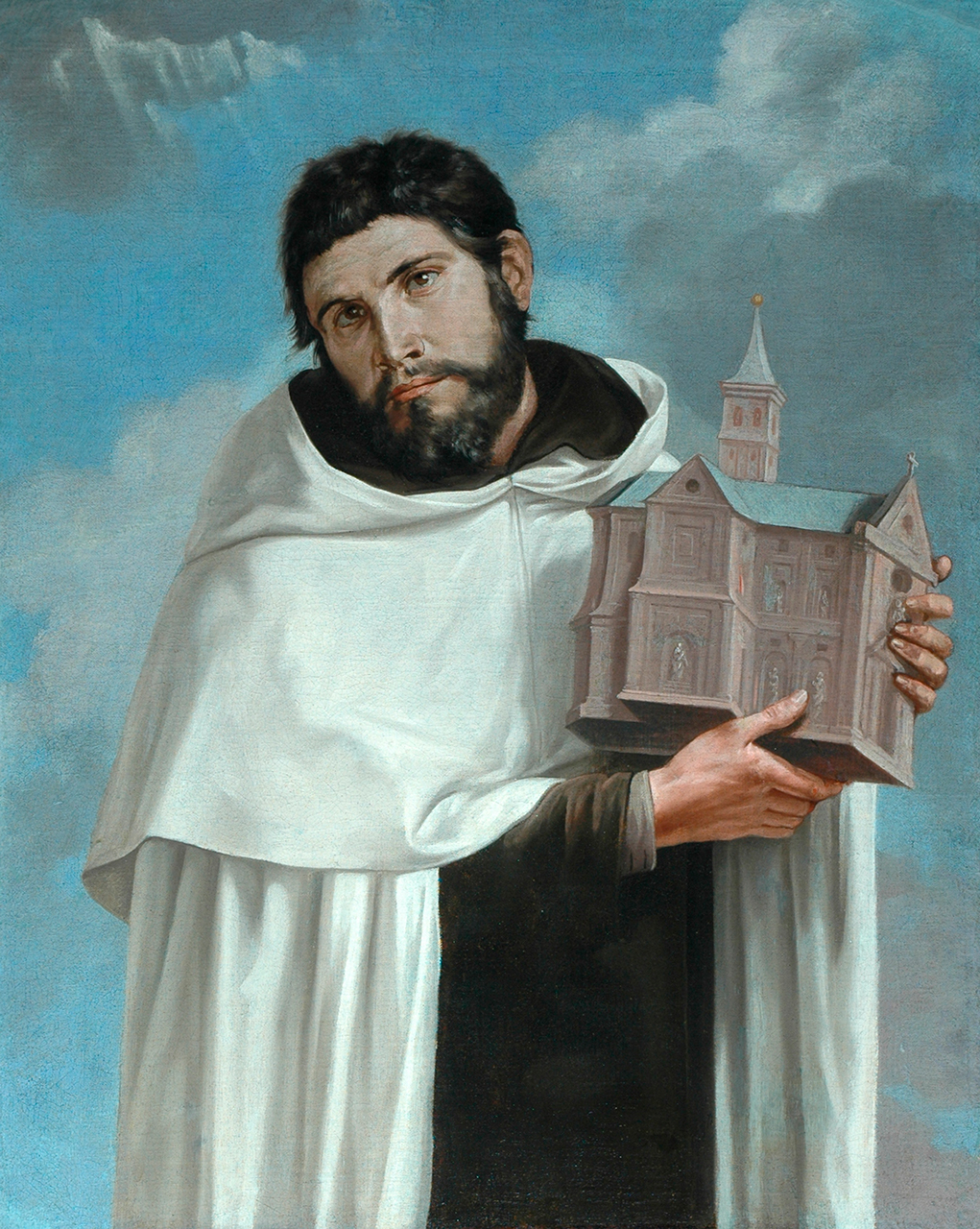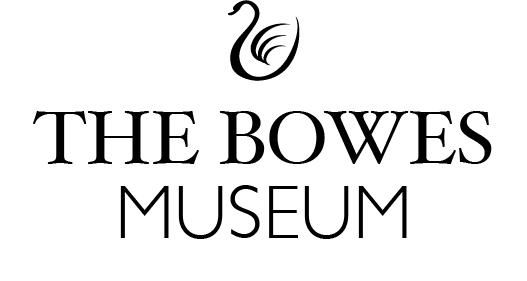
A Carmelite
Maíno’s figure of a Carmelite friar, with his furrowed brow, broad nose, and thick dark hair, appears to stare intently into the distance. The strong contrasts between his dark tunic and white cowl add a monumental quality to his stature. In his hands he holds a model of a church, a building reflecting the architectural tastes of the early seventeenth century when this painting was created. The background is filled by an unsettled sky, the light from which Maíno uses to cast gentle shadows across the friar’s face and robes.
Yet, despite the friar’s life-like qualities and the detailed appearance of the model church, the identity of the distinctive Carmelite figure remains unresolved. When the canvas first entered the possession of the Bowes family in 1862, it was thought to be a depiction of the Franciscan, St Peter of Alcántara, by an unknown artist. Scholars in the early twentieth century realized that the friar’s habit belonged to the Carmelite Order rather than the Franciscans, and since then various Carmelite saints have been proposed. These include Berthold, a crusading knight who helped found the Order in the second half of the twelfth century, and Agabus, a first-century hermit who the Carmelites claimed as a precursor.
The absence of a halo and the presence of the model church have led to suggestions that this is a portrait of a Carmelite architect, possibly Fray Alberto de la Madre de Dios (1575–1635) or Fray Gaspar de San Martín (1574–1644). However, the relatively youthful appearance of Maíno’s friar militates against this being a contemporary portrait of either of these two individuals, who were over forty years old when Maíno created this picture. It has also been noted that models of churches are more generally seen as attributes belonging to founders of religious orders rather than architects.
The late attribution of the painting to Maíno was in part based on a comparison with a work from the early 1620s, depicting St Hyacinth in the Church of Saint Peter Martyr in Toledo, where the artist used a similarly dramatic sky as a backdrop. In this picture, the grey clouds are pierced by shards of white paint, suggesting that the light, which is a critical element of the painting, has a heavenly origin and that the friar has qualities of holiness, whether or not he has reached the status of saint.
Born in 1581 into a family of well-connected cloth merchants from Pastrana in the heart of Castile, Maíno is known to have travelled to Italy in 1600. While he was there, he gained exposure to the work of artists such as Caravaggio (1571–1610), Reni (1575–1642), Gentileschi (1563–1639), and Carracci (1560–1609), before returning to Spain in 1608 with a firm grasp of their tenebrist visual effects and their close observation of the natural world. In 1611 he moved to Toledo and shortly afterwards became a Dominican friar, which reduced his output. However, in 1620 King Philip III brought him to the court in Madrid to teach drawing to the future Philip IV. This position allowed his taste for Italian tenebrism to reach a wider audience while enabling him to promote the careers of younger artists, including Diego Velázquez.
 Click to zoom and pan
Click to zoom and pan
...
Your feedback is very important to us. Would you like to tell us why?
We will never display your feedback on site - this information is used for research purposes.
Artwork Details
Title
A Carmelite, possibly Saint Agabus.
Artist
Fray Juan Bautista Maíno (Pastrana, Guadalajara, 1581 – Madrid, 1649).
Date
1620–25.
Medium and Support
Oil on canvas.
Dimensions
110.5 x 90.2 cm.
Marks and Inscriptions
None.
Acquisition Details
Bequeathed by the Founders, 1885.
Previous Owners
Francisco Javier de Quinto y Cortés (1810–60), Count of Quinto; his posthumous sale, Paris, 25 July 1862; where acquired by John and Joséphine Bowes.
Institution
The Bowes Museum, Barnard Castle, B.M.69.
Bibliography
Eric Young, Catalogue of Spanish Paintings in the Bowes Museum, 2nd ed. (Middlesborough: The Bowes Museum, 1988), pp. 94–97;
Leticia Ruiz Gómez, Juan Bautista Maíno 1581–1649 (Madrid: Museo Nacional del Prado, 2009), pp. 154–56;
Véronique Gerard Powell, ‘Spanish Paintings in the Bowes Museum’, in Spanish Art in County Durham, ed. Clare Baron & Andy Beresford (Bishop Auckland: Auckland Castle Trust, The Bowes Museum, & Durham University, 2014), pp. 56–91 (p. 71);
Mercedes Cerón, ‘Saint Agabus’, https://www.vads.ac.uk/digital/collection/NIRP/id/28328/rec/1 [accessed: 19.07.22].
